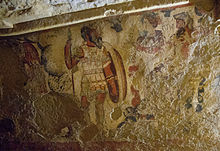Aita
Aita (also Eita ) is a demonic god of the underworld from the mythology of the Etruscans . Allegedly he holds judgment over the dead in his realm and no longer lets any soul escape from his dark realm. It can therefore be compared to the Greek gods Pluton or Hades , even if it has some properties that they do not have.
Calu , who is also passed down as an Etruscan underworld god, is often equated with Aita. Calu is a genuinely Etruscan deity for whom cultic acts were demonstrably carried out. Aita, on the other hand, appears exclusively in mythology (influenced by Greek), which in turn is reflected in the visual arts. In terms of content, however, the two correspond.
Aita appears in pictorial representations from the 4th / 3rd Century BC And is depicted as bearded and with a wolf's head. In research, this is often interpreted as a "wolf skin cap". But it is also possible that it is a living wolf who is at the service of the god of the underworld. The tomb paintings usually show him together with his presumed wife Phersipnai , who corresponds to the Greek Persephone and is therefore also a demonic deity.
The messenger of the gods of Etruscan mythology, the tower, could allegedly split up into a pair of twins and thus be at the service of the sky god Tinia on the one hand and the underworld goddess Aita on the other hand. His identity serving Aita was referred to in the Etruscan language as Turmś Aitaś (" Hermes des Hades").
literature
- Ingrid Krauskopf : Hades / Aita, Calu. In: Lexicon Iconographicum Mythologiae Classicae (LIMC). Volume IV, Zurich / Munich 1988, pp. 394-399.
- Aita. In: Simon KF Stoddart: Historical Dictionary of the Etruscans. The Scarecrow Press, Lanham / Toronto / Plymouth 2009, ISBN 978-0-8108-5471-0 , p. 9.
- Erika Simon : Gods in Harmony: The Etruscan Pantheon. In: Nancy Thomson de Grummond , Erika Simon (eds.): The Religion of the Etruscans. University of Texas Press, Austin 2006, ISBN 0-292-70687-1 , pp. 45-65, especially p. 57.
Individual evidence
- ^ Ingrid Krauskopf : The Grave and Beyond. In: Nancy Thomson de Grummond, Erika Simon (eds.): The Religion of the Etruscans. University of Texas Press, Austin 2006, ISBN 0-292-70687-1 , pp. 66–89, here p. 80, note 30.
- ^ Friedhelm Prayon : The Etruscans. History, religion, art. CH Beck, Munich 1996, ISBN 3-406-41040-5 , p. 74.
- ↑ Erika Simon : Late Etruscan religiosity. In: Dies .: Writings on Etruscan and Italian art and religion. Franz Steiner, Stuttgart 1996, ISBN 3-515-06941-0 , pp. 87-95, here p. 89 ( online ).
